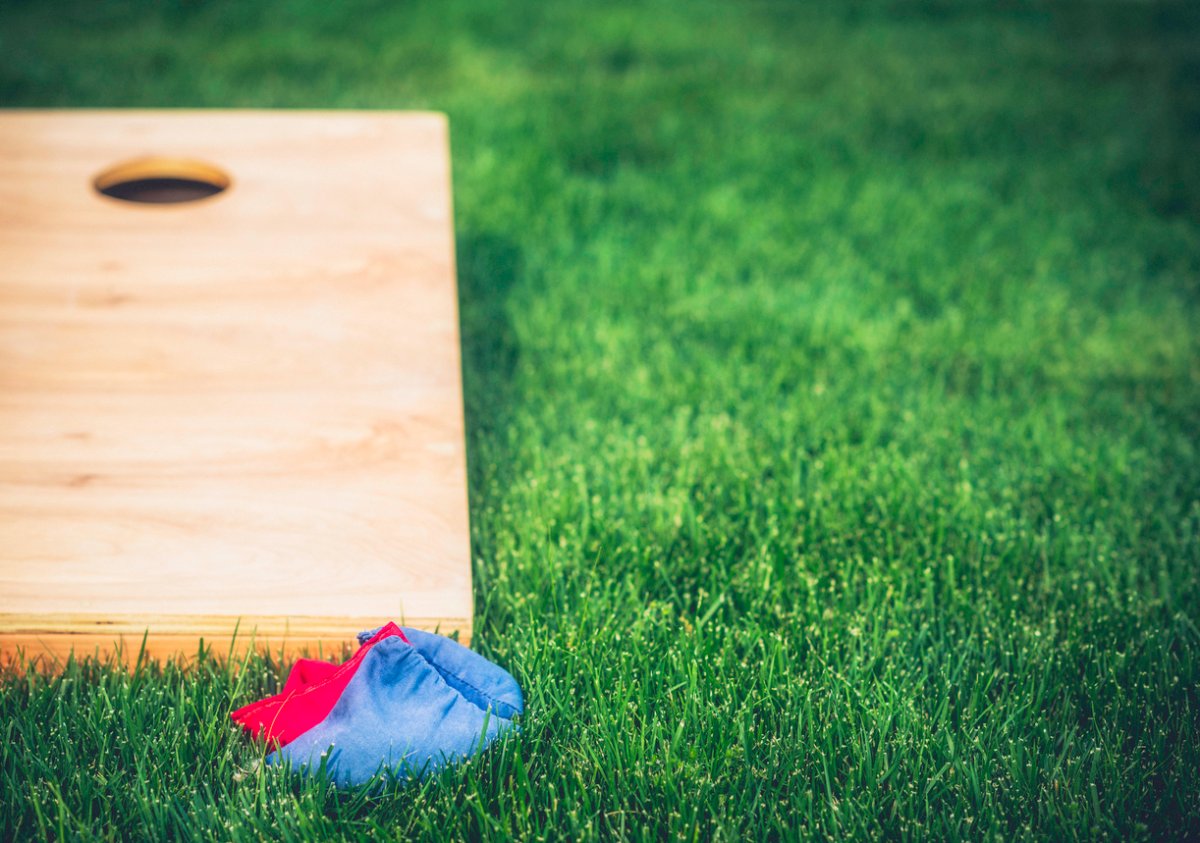

We may earn revenue from the products available on this page and participate in affiliate programs. Learn More ›
Nothing says family fun like a little bit of friendly competition! When the weather’s nice, there are many choices for great backyard outdoor games, but cornhole—with its traditional beanbag-toss vibe—invites kids of all ages to play and enjoy.
While you could buy a set of cornhole boards, some folks believe homemade is best. DIY corn hole boards require pretty simple construction, and they’re easy enough to complete in a weekend by following the steps below.
You also can make a set of regulation cornhole bags if you have sewing skills and some feed corn. If not, you can find a set of cornhole bags on Amazon for between $20 and $40. With a finished project that almost everyone can enjoy, DIY cornhole boards is an excellent summer project.
Once you’ve built your board, procured the bags, and picked teams, you might just find yourself at the start of a new family tradition—or grudge match!
Skill Level: Moderate
Cornhole isn’t just fun game to play with the family; it’s also fun to spend time building a DIY cornhole set together. With a few hours of time, some instruction, and the ultimate tournament on the horizon, many older kids can do most of the work themselves (under adult supervision, of course).
There are some basic power tools and saws involved in making cornhole boards, but nothing the average DIYer can’t handle—and many own these tools already. Younger kids might need to take a break when the jigsaw comes out—it’s loud and too dangerous for little hands. But with your supervision, tweens and teens will be able to learn some basic woodworking skills.
The supplies list includes a sheet of plywood. If a full sheet of plywood and 2x4s don’t fit in the car, ask someone at your local big-box hardware store to cut the plywood and 2×4 boards at the time of purchase.
Tools & Materials
Bobvila.com may earn a commission from purchases made through these links.
- Tape measure
- Speed Square
- Carpenter’s pencil
- Power Drill
- Set of drill bits for wood
- Phillips head driver bit
- 3-inch deck screws
- 24-inch by 48-inch plywood boards, ¾ inches thick (cabinet-grade is best, as it will be treated for weather protection)
- Circular saw
- Compass and pencil
- Jigsaw
- 6-inch hole saw
- Four 12-inch 2×4 boards (for the legs)
- Spackling knife
- Four ⅜-inch x 3 ½-inch carriage bolts
- Eight regulation cornhole beanbags (6-inch x 6-inch, each filled with 2 cups of feed corn)
- 48-inch 2×4 boards (for the long sides of the frame)
- 21-inch 2×4 boards (for the short sides of the frame)
- Wood glue
- 1¼-inch trim screws
- Sandpaper
- Wood filler or spackle
- Nuts and washers
- Paintbrush, roller, and tray set
- Primer/stain killer
- Painter’s tape
- Paint of your choice
- Polyacrylic finish coat
- Two utility pulls (anywhere between 5- and 6 1/2-inch should work)
Making Your Own DIY Cornhole Boards in 11 Simple Steps
A cornhole tournament can be a blast. With everyone pairing up and competing to knock each other out of the bracket, there’s plenty of time for good-natured ribbing and awesome memories.
Making your own cornhole set can be just as fun if approached with the same positive attitude. The following steps offer a quick, simple roadmap to build your own cornhole boards. While it’s not a difficult task, be sure to read all of the instructions before getting started, and then take it one step at a time.
STEP 1: Lay out the board frames.
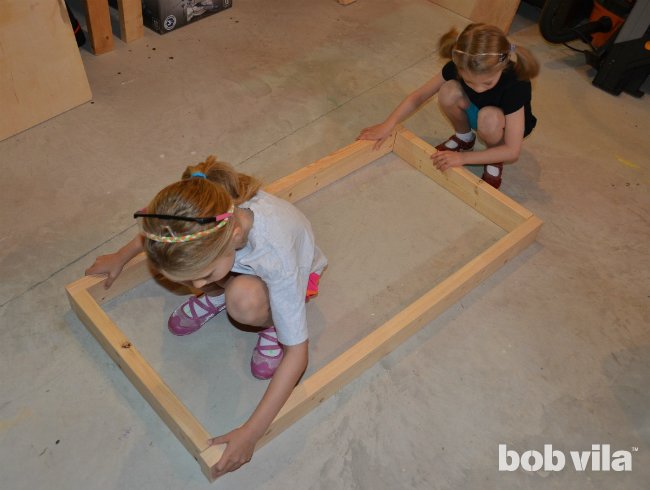
The first step to build a cornhole board is to lay out the frames. Find a large, flat surface that is available to construct the frame.
First, there are two ways to orient a 2×4: on the flat or on edge. “On the flat” would be when one of the 3 ½-inch sides are laying on the ground. “On edge” would be when the shorter 1 ½-inch side is on the ground. For this project, orient the 2x4s on edge.
Arrange the rectangular frame of your first cornhole board by laying out your 2×4 lumber. Place the longer lengths (the 48-inch 2x4s) parallel to each other. Place the 21-inch boards between these longer boards at their ends.
This next step is very important: The 21-inch lengths go between the 48-inch boards. And there’s a reason for it.
Cornhole boards are supposed to be 48 inches long by 24 inches wide. Given that a 2×4 is actually 1 1/2 inches thick, the shorter boards (21 inches) plus the two 1 1/2-inch-thick outer boards come out to a total width of 24 inches. Measure to ensure your frame is regulation size.
STEP 2: Drill pilot holes for the frame’s screws.
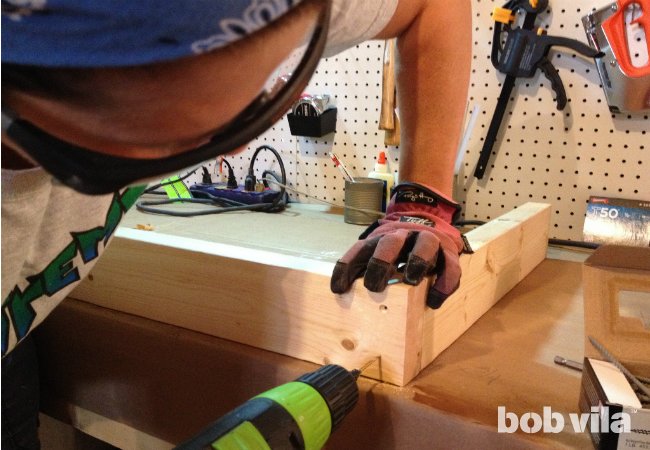
With the frame laid out, it’s time to attach the individual boards to each other. For this step, grab a drill and a ⅛-inch drill bit.
Measure ¾ of an inch in from each end of the 48-inch boards, making a pencil mark on the flat side of the 2×4. Use the speed square to draw a line at this mark, spanning across the width of the board. Drill two holes on each line, each approximately ¾ of an inch from the edge.
STEP 3: Glue and screw the frame.
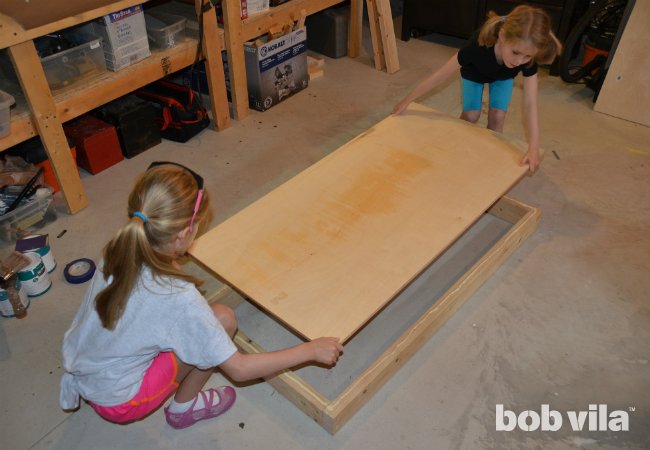
With the holes drilled, attaching the frame boards to each other is a cinch. Run a small bead of glue on the end of a 21-inch board and align the end with the end of the 48-inch board. Run two screws from the outside of the 48-inch board into the end of the 21-inch board. Repeat this process at all four corners.
Do your best to ensure that the frame stays square through this step. The following step will allow for a bit of adjustment, but it’s best to have as square a foundation as possible.
STEP 4: Cut and attach the plywood tops.
If the plywood tops haven’t been cut already, now’s the time. A circular saw is the easiest option, but a bit of patience and the jigsaw will do the trick as well. Measure, mark, and cut the plywood into two 24-inch-wide by 48-inch-long boards.
Run a bead of wood glue along the top edge of the frame, and lay the 2-foot x 4-foot piece of plywood on top. Then, attach the plywood to the frame with 1 1/4-inch trim screws (approximately 20 on each board). It’s a good idea to predrill the board using the ⅛-inch drill bit to avoid splitting, and ensure that the screw heads are slightly countersunk.
Pro Tip: If the frame is a bit out of square, line the plywood top flush with two adjacent corners and run a screw through each. This should allow for enough flexibility to rack the frame into shape, at which point the other two corners can be attached to hold it in place. Then continue with the rest of the screws.
STEP 5: Mark out the cornhole board holes.
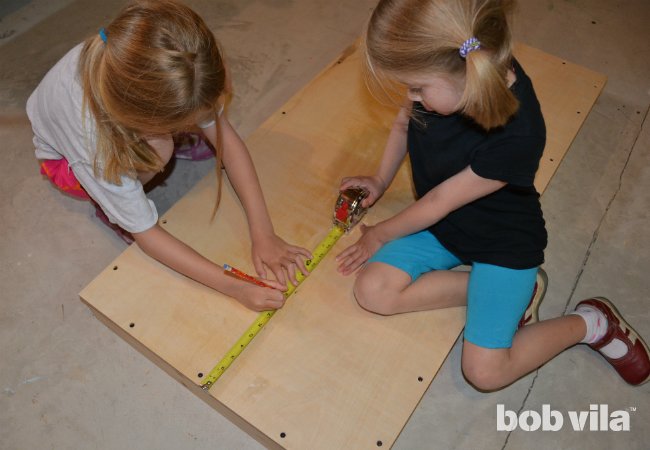
The next step is creating the holes. Believe it or not, this is a critical step to ensure the board meets regulation standards.
Hook the tape measure on the end of the board (one of the short sides), and make a pencil mark on the face of the plywood at 9 inches. Then, hook the tape on one of the long sides of the board, and make a pencil mark on the plywood at 12 inches. Align these two marks to find the center of the hole that the beanbags will fall into.
The hole needs to be 6 inches in diameter, so set the compass to 3 inches and draw a circle around this point.
STEP 6: Cut the cornhole board holes.
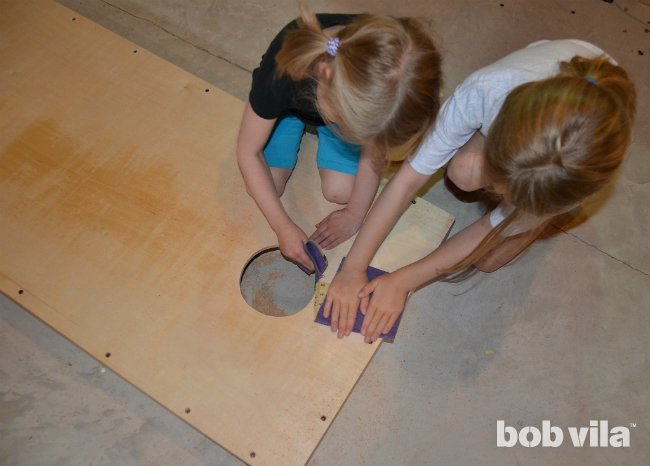
Cutting out the 6-inch hole might seem intimidating, but it’s well within the capabilities of an experienced DIYer. The following two options will get the job done, so it just comes down to preference and tool availability. (The Home Depot also sells plywood cornhole sheets with precut 6-inch holes—buying these could save you time and energy on this step.)
Option 1: Cut with a jigsaw.
Use a ⅜-inch drill bit to drill a hole inside the circle, about ½-inch from the line. Then, insert the jigsaw, and cut along the guideline to create the hole.
Be sure to sand the edges smooth with sandpaper. If not, the beanbags can hang up on the edge, preventing the coveted 3-point cornhole score. And no one wants to play a game scored 1 point at a time.
Option 2: Cut with a hole saw bit.
The simpler option is to use a 6-inch hole saw bit to cut the hole open. With the hole saw bit chucked into the drill, put the point of the drill bit on the center mark. Squeeze the trigger and apply light pressure, allowing the hole saw to cut the hole.
Again, be sure to sand the hole smooth with sandpaper to allow for fast-paced, high-scoring games.
STEP 7: Prepare and drill holes for the legs.
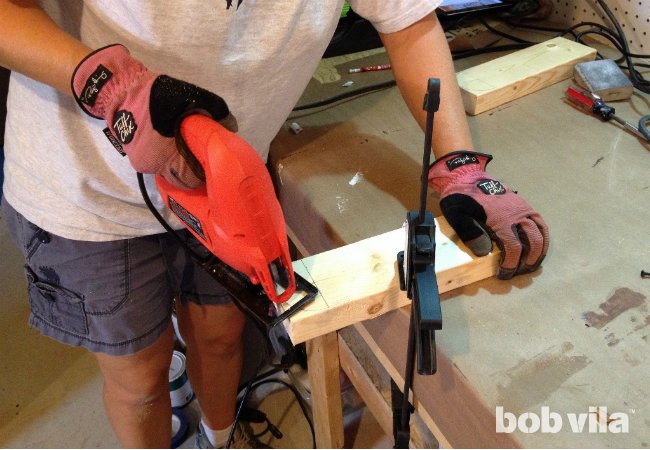
For a DIY cornhole board to work, one end of the board needs to be elevated with legs that are 12 inches long. Measure and cut the legs to length using a circular saw.
The legs need to collapse or fold into the frame for easy storage, so one end of each board needs to be rounded. To make this happen, measure and mark a point that is both 1 3/4 inches from the top and 1 3/4 inches from each side. Set the compass at 1 3/4 inches and draw a half-circle from that mark. Cut with a jigsaw and sand smooth.
The center mark used for the compass will also serve as the mark to drill for the carriage bolt. Using the ⅜-inch drill bit, drill a hole at the mark. With the cornhole board upside down, place the rounded end of the leg inside the top corner of the frame, and use the existing hole as a guide for drilling a corresponding hole through the frame.
STEP 8: Fill the visible screw head holes.
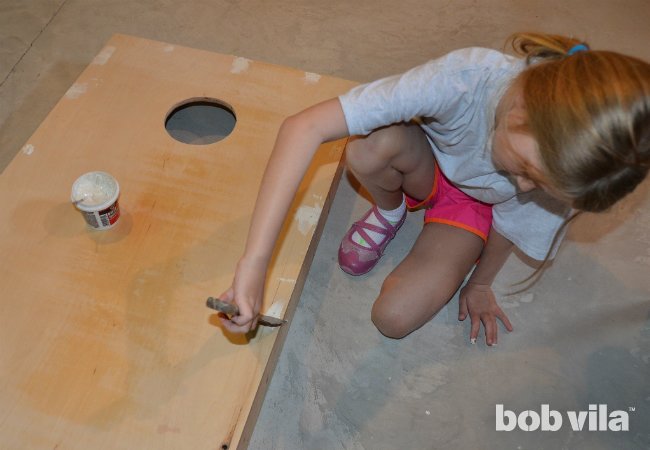
The top of a DIY cornhole board needs to be as smooth as possible to prevent any unfair advantages. This means filling the screw holes and sanding everything until it’s smooth.
Using the spackle knife, force a bit of wood filler into each screw hole on the face of the board. Remove the excess by scraping the knife across the surface. Allow the wood filler to dry, and then use a piece of sandpaper to sand everything smooth. If there are still edges, ridges, or depressions, repeat this step until it’s smooth.
STEP 9: Stain and paint the cornhole boards.
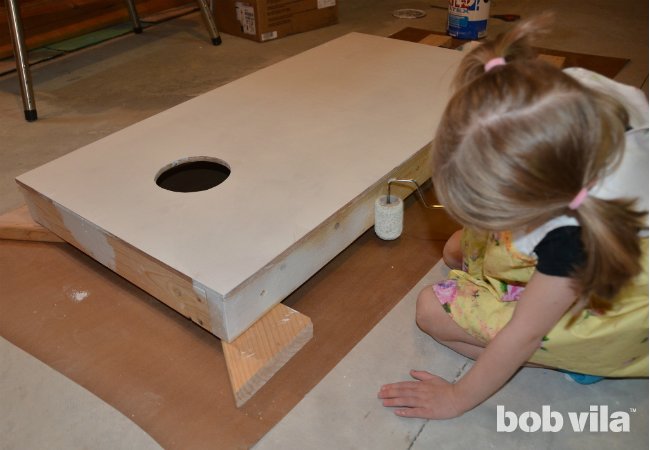
These DIY cornhole boards aren’t full-blown construction projects, but they do take effort, time, and materials. For that reason, it’s important to protect the investment and hard work with proper weather protection.
Using a paintbrush or roller, apply a coat of stain killer or primer to the board’s top, sides, and legs.
While the primer dries, dream up the design for the face of the board. The traditional decoration for cornhole includes a triangle that points up toward the hole in the board, but this is open to customization. Consider using a bullseye pattern, the family initial, or a variety of other designs. The possibilities are endless.
With an agreed-upon design in mind, use painter’s tape to mask it out. Use the paint roller or paintbrush to paint the face with the desired colors. Finish it with a polyacrylic top coat so that the beanbags slide well across the board’s surface.
STEP 10: Secure the legs.

Attaching the legs is simple, but it’s critical to allow them to dry completely from the previous step. If they aren’t dry, the legs could cure in place and cause damage.
Assemble the leg hardware as follows: Place a carriage bolt through the hole so that the rounded head is on the outside of the frame. Next, place a washer on the bolt. Follow the washer with the leg, followed again by a washer, and finally, the nut. The washer between the frame and the leg will allow the leg to swivel, even if the carriage bolt is tight.
This also is the point to attach the utility pulls, which act as carrying handles. Install one handle on the side of each board, slightly off center toward the hole to promote balance. Generally speaking, this involves holding the handle in place, marking the screw holes with a pencil, predrilling, and screwing the handles in place.
STEP 11: Repeat steps for the second board.
If space didn’t allow for building both boards at the same time, repeating these steps is necessary to build the other half of the DIY cornhole set.
Repeat Steps 1 through 10 to make the second board. Consider painting a different design on the surface of each board.
Finally, enjoy!
With both DIY cornhole boards assembled, painted, and dry, it’s time to kick off the family cornhole tournament. Grab the boards and find a level area in the backyard.
Regulations call for 27 feet of space between the front of each board, so it’s helpful to keep the tape measure on hand. Kid cornhole rules allow juniors to stand up to 6 feet in front of the board, but everyone else must stay behind. While these are the official regulations, it’s your tournament, so interpret and adjust them as you wish.
So what are you waiting for? Just call up your extended family or neighbors, and let the games begin.
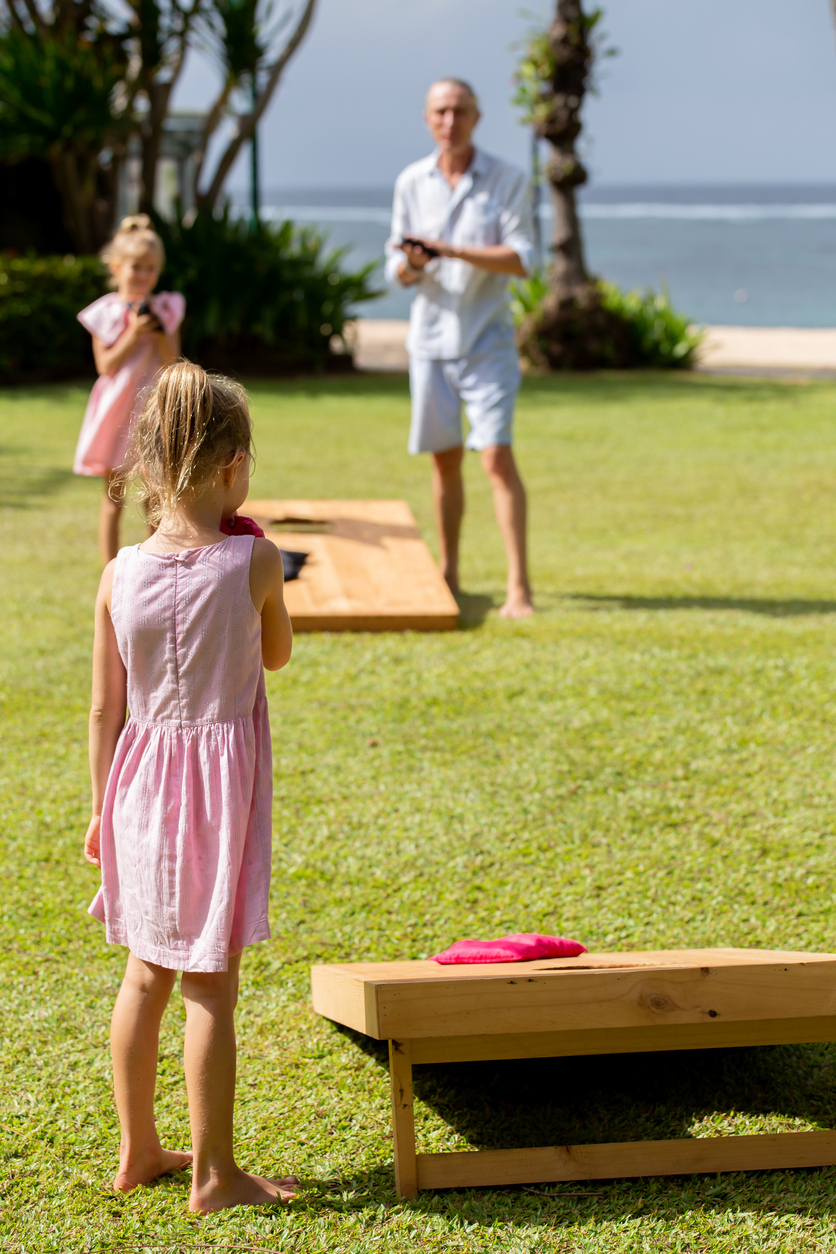
FAQs About DIY Cornhole
To truly enjoy your new DIY cornhole set, get all of the questions about rules and regulations out of the way. The following are answers to some of the most frequently asked questions about how to play cornhole.
Here is a basic overview of cornhole rules:
- The distance between the front of each board is 27 feet, except for juniors (12 and under).
- Stepping in front of the board is a foul for anyone older than 12.
- Bag In-The-Count (or Woody) is a bag that comes to rest anywhere on top of the board. It’s worth one point.
- Bag In-The-Hole (Cornhole) is a bag that falls into the hole or is knocked into the hole. It’s worth three points.
- Games are played to a score of 21, with cancellation scoring in place.
- Cancellation scoring means the points of one player cancel out the points of the opposing players, round-by-round.
There are more rules and regulations, which you can find on the American Cornhole Association website.
The regulation distance between the front of the cornhole boards is 27 feet, but juniors stand as close as 21 feet away. Those are the rules for regulation, but feel free to adjust them to your backyard tournament’s needs.
No. One-hand, underhand tosses are the only tosses allowed by regulation. Overhand, above-the-head, and two-hand releases are considered fouls by cornhole regulations.
Technically, you only need one board to enjoy a game of cornhole, but two boards allow a member of each team to stand on each side, removing the need to walk back and forth to collect beanbags.
